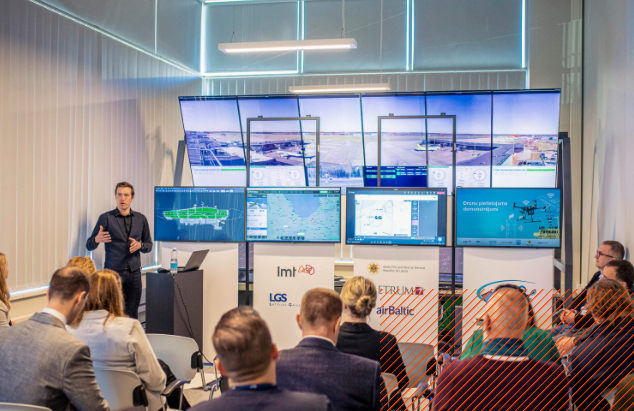The GOF 2.0 roadshow in Riga demonstrated successful integration of drones into manned airspace at the GOF 2.0 Roadshow in Riga. The demonstration was conducted by LMT in collaboration with Latvijas Gaisa Satiksme (LGS), the local air traffic controller, and the GOF2.0 consortium.
During the demonstration that took place in the vicinity of Riga International Airport, four scenarios were executed under active air traffic conditions:
- Coordinated flights of piloted aviation and UAV in Riga airport
- First Responder UAS operation near Riga airport
- Inspection of a construction site
- Inspection of freeport of Riga in RIGA CTR
As noted by Maria Tamm, GOF2.0 project coordinator at EANS, the goal was to demonstrate and understand how easily Communications Navigation and Surveillance (CNS) and Aeronautical Information Manual (AIM) data and systems, as well as local unmanned and manned aircraft operators can be integrated into the GOF2.0 solution. This was to showcase the international scalability of the U-space architecture. U-space is an ecosystem facilitating a Safe and Secure Integration of drones.
To calculate where an unmanned aerial vehicle (UAV) can safely fly beyond the visual line of sight (BVLOS), LMT’s cellular network data were integrated into the Dimitor’s AirboneRF platform.
GOF 2.0 is an EU-funded project focused on the safe integration of unmanned aerial vehicles (UAVs) in urban airspace. LMT was chosen as the cellular network provider for the demonstration in Latvia, where the focus was on the integration of UAVs into urban areas for various purposes and the role of cellular networks, especially 5G coverage, in achieving this.
Partners demonstrated digitization of the airspace and the automation of the processes as a foundation for BVLOS drone operations. AirborneRF was used to analyze airspace connectivity and ground risk and exchange the required 4G/5G network data from LMT with the U-Space.
Gints Jakovels, LMT Innovation Lead said: “Mobile networks and 5G will play a critical role in the successful incorporation of UAVs in common airspace. At the GOF2.0 Roadshow in Riga, LMT aims to demonstrate how mobile networks can support the safe inclusion of UAVs into the common air traffic by enabling UAV-to-UAV and UAV-to-ground communication. This is crucial for flight risk assessment and hence successful deployment of drone technologies”.
Thomas Wana, CTO & Co-founder of Dimetor said: “The demonstration was organized by the GOF 2.0 consortium, LMT, Latvijas Gaisa Satiksme (LGS), METRUM, State Fire and Rescue Service Republic of Latvia, and AirBaltic Training. Demonstrations of the use of GOF 2.0 drones are in collaboration with the Comp4Drones project.”
For more information visit:




